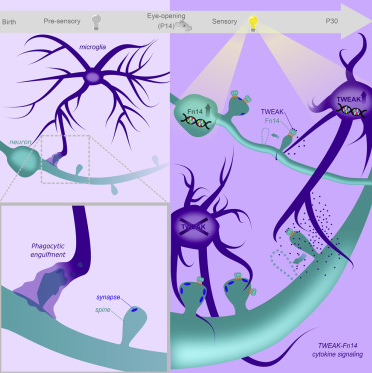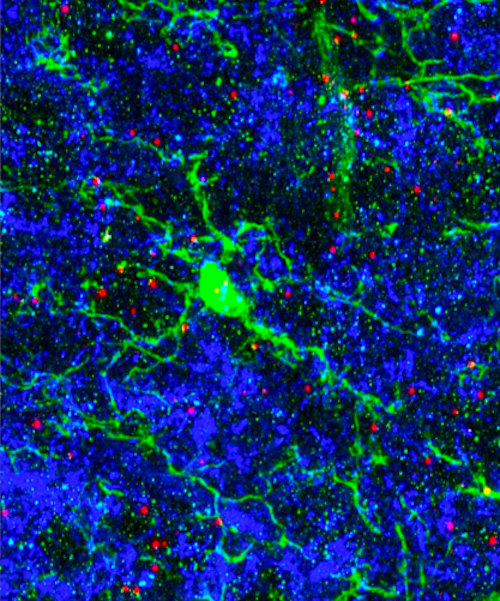|

CLICK ON weeks 0 - 40 and follow along every 2 weeks of fetal development
|
||||||||||||||||||||||||||||
|
Developmental Biology - Immune Cells Sculpt Our Brain Immune Cells Sculpt Our Brain  Microglia affect the density of neuronal connections. CREDIT Lucas Cheadle Highlights • Experience induces Fn14 expression in neurons and TWEAK expression in microglia • Fn14 increases the number of spine-associated synapses when not bound by TWEAK • Microglial TWEAK signals through neuronal Fn14 to locally decrease synapse numbers • Microglia-driven synapse loss occurs through a non-phagocytic mechanism Summary Sensory experience remodels neural circuits in the early postnatal brain through mechanisms that remain to be elucidated. Applying a new method of ultrastructural analysis to the retinogeniculate circuit, we find that visual experience alters the number and structure of synapses between the retina and the thalamus. These changes require vision-dependent transcription of the receptor Fn14 in thalamic relay neurons and the induction of its ligand TWEAK in microglia. Fn14 functions to increase the number of bulbous spine-associated synapses at retinogeniculate connections, likely contributing to the strengthening of the circuit that occurs in response to visual experience. However, at retinogeniculate connections near TWEAK-expressing microglia, TWEAK signals via Fn14 to restrict the number of bulbous spines on relay neurons, leading to the elimination of a subset of connections. Thus, TWEAK and Fn14 represent an intercellular signaling axis through which microglia shape retinogeniculate connectivity in response to sensory experience. Authors Lucas Cheadle, Samuel A. Rivera, Jasper S. Phelps, Katelin A. Ennis, Beth Stevens, Linda C. Burkly, Wei-Chung Allen Lee and Michael E. Greenberg. Acknowledgements The authors declare no competing financial interests. This is an open-access article distributed under the terms of the Creative Commons Attribution 4.0 International license, which permits unrestricted use, distribution and reproduction in any medium provided that the original work is properly attributed. Brann along with Dr. Ratna Vadlamudi, Molecular Biologist, Professor of Obstetrics and Gynecology, University of Texas Health, San Antonio, are Co-corresponding Authors of the study and Co-principal Investigators on the National Institute of Neurological Disorders and Stroke grant funding the research (Grant R01NS088058). Return to top of page. | Sep 17 2020 Fetal Timeline Maternal Timeline News  Microglia affect the density of neuronal connections. Microglial cells (stained in green), the immune cells of the mouse brain, send branches into areas with many neuronal connections (stained blue). Microglia make an immune signal, or cytokine, called TWEAK at the ends of their branches (stained in red). Microglia that contain large amounts of TWEAK (are deeper red) contact fewer neuronal connections (seen as black areas without blue connections). CREDIT Lucas Cheadle
|
||||||||||||||||||||||||||||

